Study on Neutron Irradiation-Induced Structural Defects of GaN-Based Heterostructures
Abstract
:1. Introduction
2. Materials and Experiments
3. Results and Discussion
4. Conclusions
Author Contributions
Acknowledgments
Conflicts of Interest
References
- Collins, K.C.; Armstrong, A.M.; Allerman, A.A.; Vizkelethy, G.; van Deusen, S.B.; Leonard, F.; Talin, A.A. Proton irradiation effects on minority carrier diffusion length and defect introduction in homoepitaxial and heteroepitaxial n-GaN. J. Appl. Phys. 2017, 122. [Google Scholar] [CrossRef]
- Lei, Z.F.; Guo, H.X.; Tang, M.H.; Zeng, C.; Zhang, Z.G.; Chen, H.; En, Y.F.; Huang, Y.; Chen, Y.Q.; Peng, C. Degradation mechanisms of AlGaN/GaN HEMTs under 800 MeV Bi ions irradiation. Microelectron. Reliabil. 2018, 80, 312–316. [Google Scholar] [CrossRef]
- Chen, J.; Puzyrev, Y.S.; Zhang, C.X.; Zhang, E.X.; McCurdy, M.W.; Fleetwood, D.M.; Schrimpf, R.D.; Pantelides, S.T.; Kaun, S.W.; Kyle, E.C.H.; et al. Proton-induced dehydrogenation of defects in AlGaN/GaN HEMTs. IEEE Trans. Nuclear Sci. 2013, 60, 4080–4086. [Google Scholar] [CrossRef]
- Kumar, A.; Singh, R.; Kumar, P.; Singh, U.B.; Asokan, K.; Karaseov, P.A.; Titov, A.I.; Kanjilal, D. In-situ transport and microstructural evolution in GaN Schottky diodes and epilayers exposed to swift heavy ion irradiation. J. Appl. Phys. 2018, 123. [Google Scholar] [CrossRef]
- Kurakin, A.M.; Vitusevich, S.A.; Danylyuk, S.V.; Hardtdegen, H.; Klein, N.; Bougrioua, Z.; Danilchenko, B.A.; Konakova, R.V.; Belyaev, A.E. Mechanism of mobility increase of the two-dimensional electron gas in AlGaNGaN heterostructures under small dose gamma irradiation. J. Appl. Phys. 2008, 103. [Google Scholar] [CrossRef]
- McClory, J.W. The Effect of Radiation on Electrical Properties of Aluminum Gallium Nitride/Gallium Nitride Heterostructures; Technology Air University: Dayton, OH, USA, 2008. [Google Scholar]
- Polyakov, A.Y.; Smirnov, N.B.; Govorkov, A.V.; Markov, A.V.; Pearton, S.J.; Kolin, N.G.; Merkurisov, D.I.; Boiko, V.M. Neutron irradiation effects on electrical properties and deep-level spectra in undoped n-AlGaN/GaN heterostructures. J. Appl. Phys. 2005, 98. [Google Scholar] [CrossRef]
- McClory, J.W.; Petrosky, J.C. Temperature Dependent Electrical Characteristics of Neutron Irradiated AlGaN/GaN HFETs; Institute of Electrical and Electronics Engineers Inc.: Piscataway, NJ, USA, 2007; pp. 1969–1974. [Google Scholar]
- Gaubas, E.; Ceponis, T.; Deveikis, L.; Meskauskaite, D.; Miasojedovas, S.; Mickevicius, J.; Pavlov, J.; Pukas, K.; Vaitkus, J.; Velicka, M.; et al. Study of neutron irradiated structures of ammonothermal GaN. J. Phys. D Appl. Phys. 2017, 50, 135102. [Google Scholar] [CrossRef]
- Lv, L.; Li, P.; Ma, X.; Liu, L.; Yang, L.; Zhou, X.; Zhang, J.; Cao, Y.; Bi, Z.; Jiang, T.; Zhu, Q.; Hao, Y. Fast and Thermal Neutron Radiation Effects on GaN PIN Diodes. IEEE Trans. Nucl. Sci. 2017, 64, 643–647. [Google Scholar] [CrossRef]
- Xu, Z.H.; Zhang, J.C.; Zhang, Z.F.; Zhu, Q.-W.; Duan, H.-T.; Hao, Y. The effects of vicinal sapphire substrates on the properties of AlGaN/GaN heterostructures. Chin. Phys. B 2009, 18, 5457. [Google Scholar]
- Chandolu, A.; Song, D.Y.; Holtz, M.E.; Gherasoiu, I.; Nikishin, S.A.; Bernussi, A.; Holtz, M.W. X-ray diffraction and photoluminescence studies of InN grown by plasma-assisted molecular beam epitaxy with low free-carrier concentration. J. Electron. Mater. 2009, 38, 557–562. [Google Scholar] [CrossRef]
- Zhang, M.L.; Wang, X.L.; Xiao, H.L.; Yang, C.; Wang, R. Influence of neutron irradiation on the deep levels in GaN, Solid-State and Integrated Circuit Technology. In Proceedings of the 10th IEEE International Conference on Solid-State and Integrated Circuit Technology (ICSICT), Shanghai, China, 1–4 November 2010. [Google Scholar]
- Pearton, S.J.; Deist, R.; Ren, F.; Liu, L.; Polyakov, A.Y.; Kim, J. Review of radiation damage in GaN-based materials and devices. J. Vac. Sci. Technol. A 2013, 35, 050801. [Google Scholar] [CrossRef]
- Lorenz, K.; Marques, J.G.; Franco, N.; Alves, E.; Peres, M.; Correia, M.R.; Monteiro, T. Defect studies on fast and thermal neutron irradiated GaN. Nucl. Instrum. Methods Phys. Res. B Beam Interact. Mater. At. 2008, 266, 2780–2783. [Google Scholar] [CrossRef]
- Roy, T.; Zhang, E.X.; Puzyrev, Y.S.; Fleetwood, D.M.; Schrimpf, R.D.; Choi, B.K.; Hmelo, A.B. Process dependence of protoninduced degradation in GaN HEMTs. IEEE Trans. Nucl. Sci. 2010, 57, 3060–3065. [Google Scholar]
- Lv, L.; Ma, J.G.; Cao, Y.R.; Zhang, J.C.; Li, L.; Xu, S.R.; Ma, X.H.; Ren, X.T.; Hao, Y. Study of proton irradiation effects on AlGaN/GaN high electron mobility transistors. Microelectron. Reliabil. 2011, 51, 2168–2172. [Google Scholar] [CrossRef]
- Cai, S.J.; Tang, Y.S.; Li, R.; Wei, Y.Y.; Wong, L.; Chen, Y.L.; Wang, K.L.; Chen, M.; Zhao, Y.F.; Schrimpf, R.D.; et al. Annealing behavior of a proton irradiated AlxGa1-xN/GaN high electron mobility transistor grown by MBE. IEEE Trans. Electron. Devices 2000, 47, 304–307. [Google Scholar] [CrossRef]
- Summers, G.P.; Burke, E.A.; Dale, C.J.; Wolicki, E.A.; Wolicki, E.A.; Gehlhausen, M.A. Correlation of particle induced displacement damage in silicon. IEEE Trans. Nucl. Sci. 1987, 34, 1133–1139. [Google Scholar] [CrossRef]

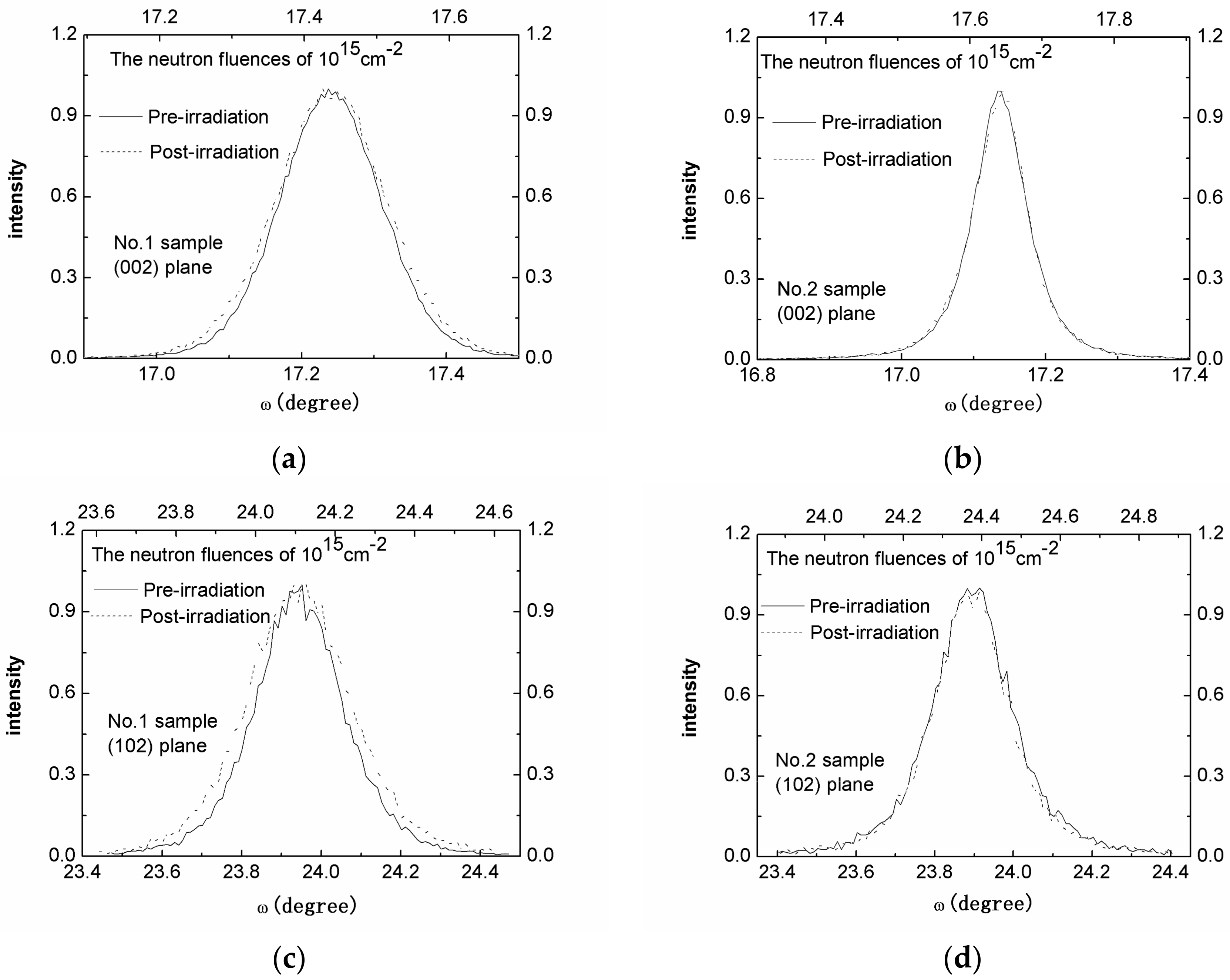
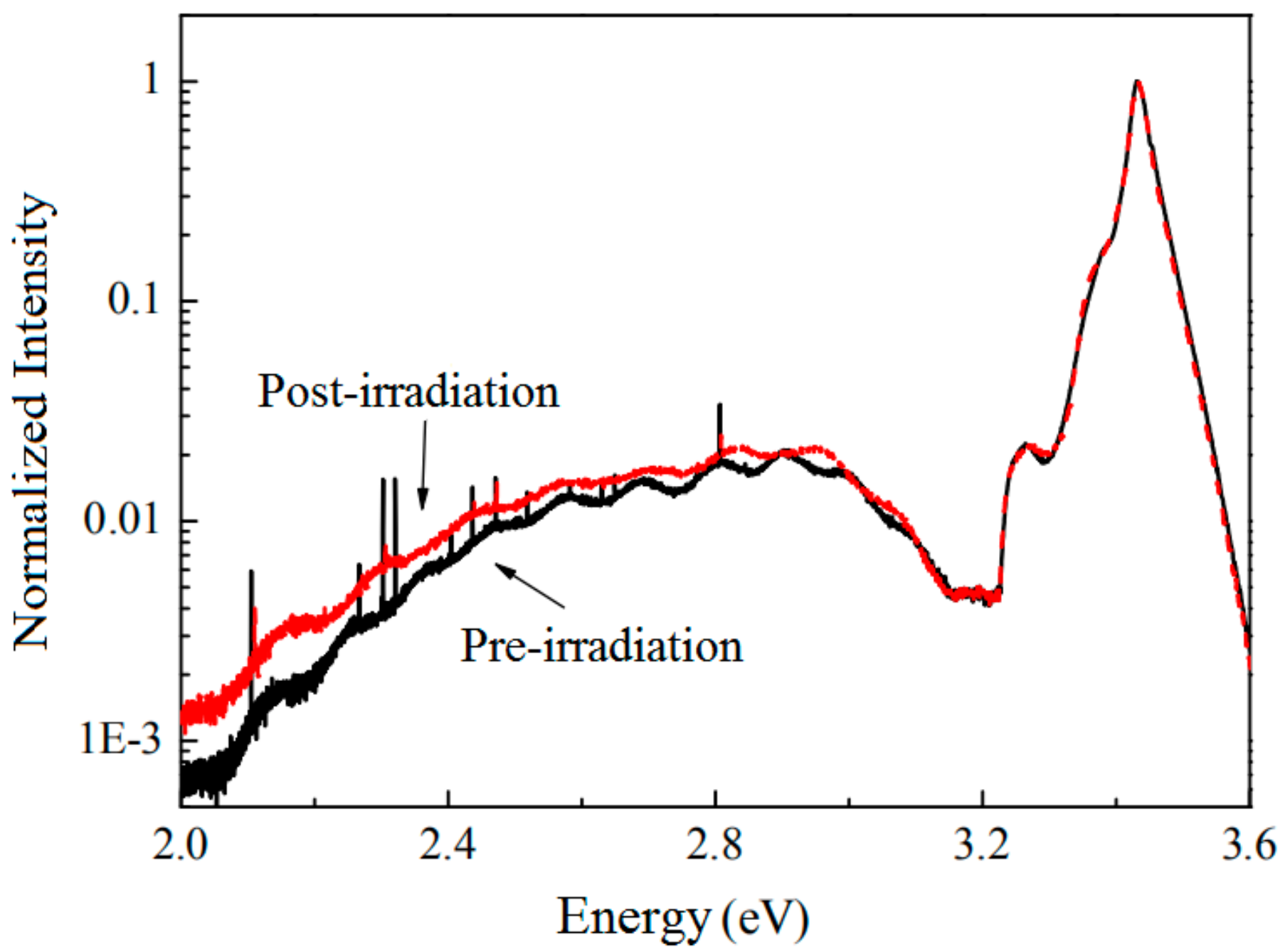
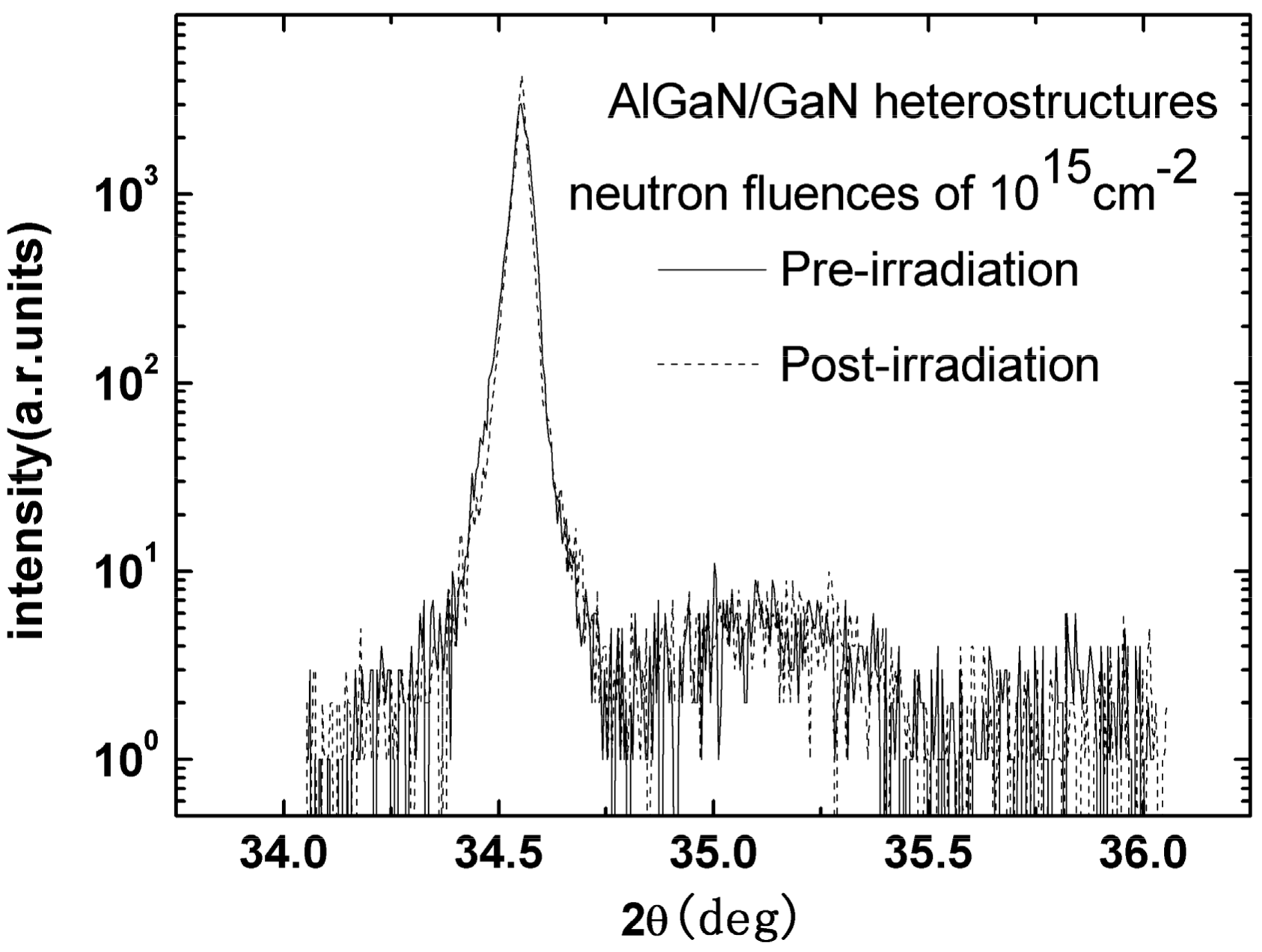
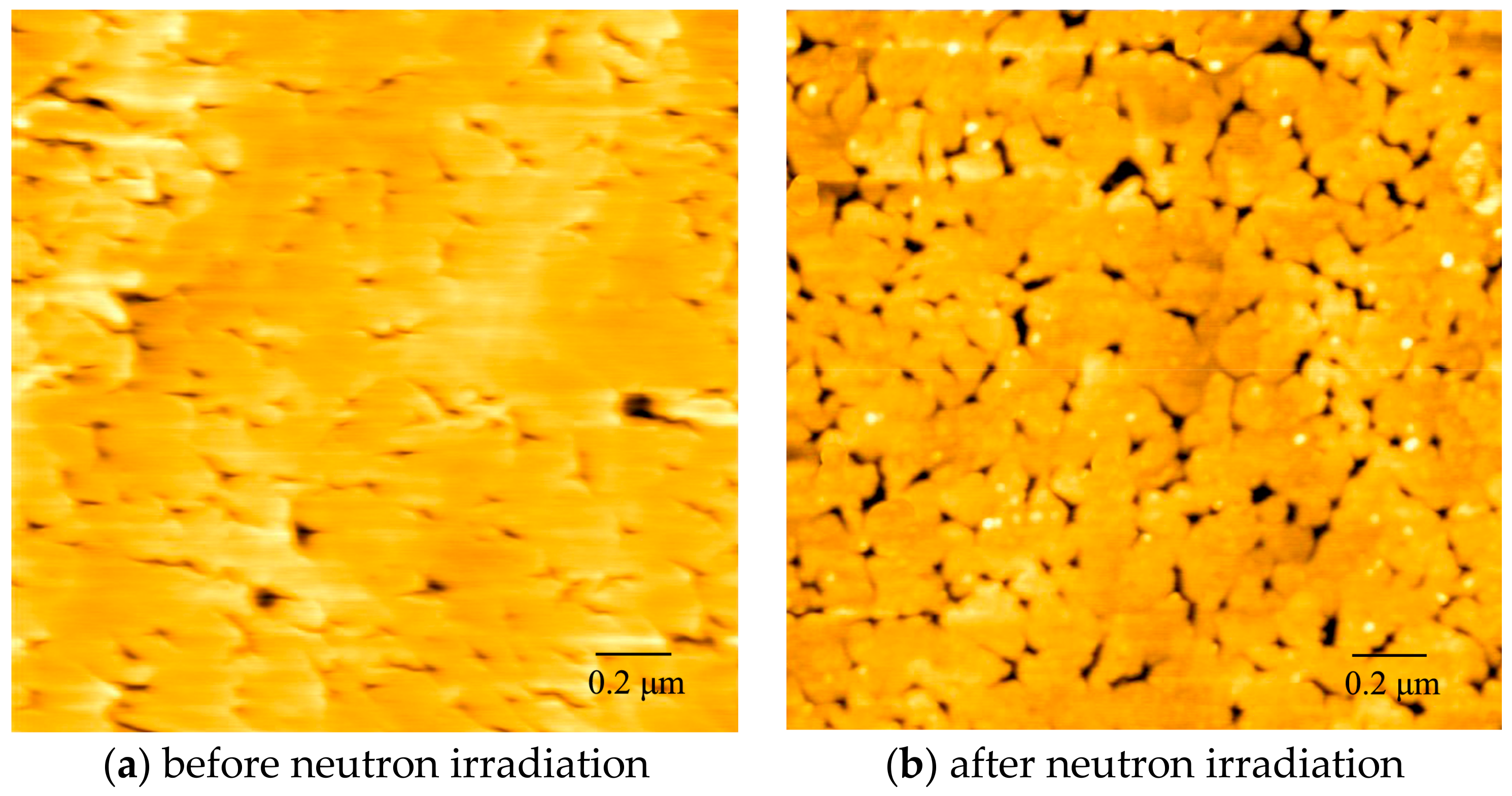
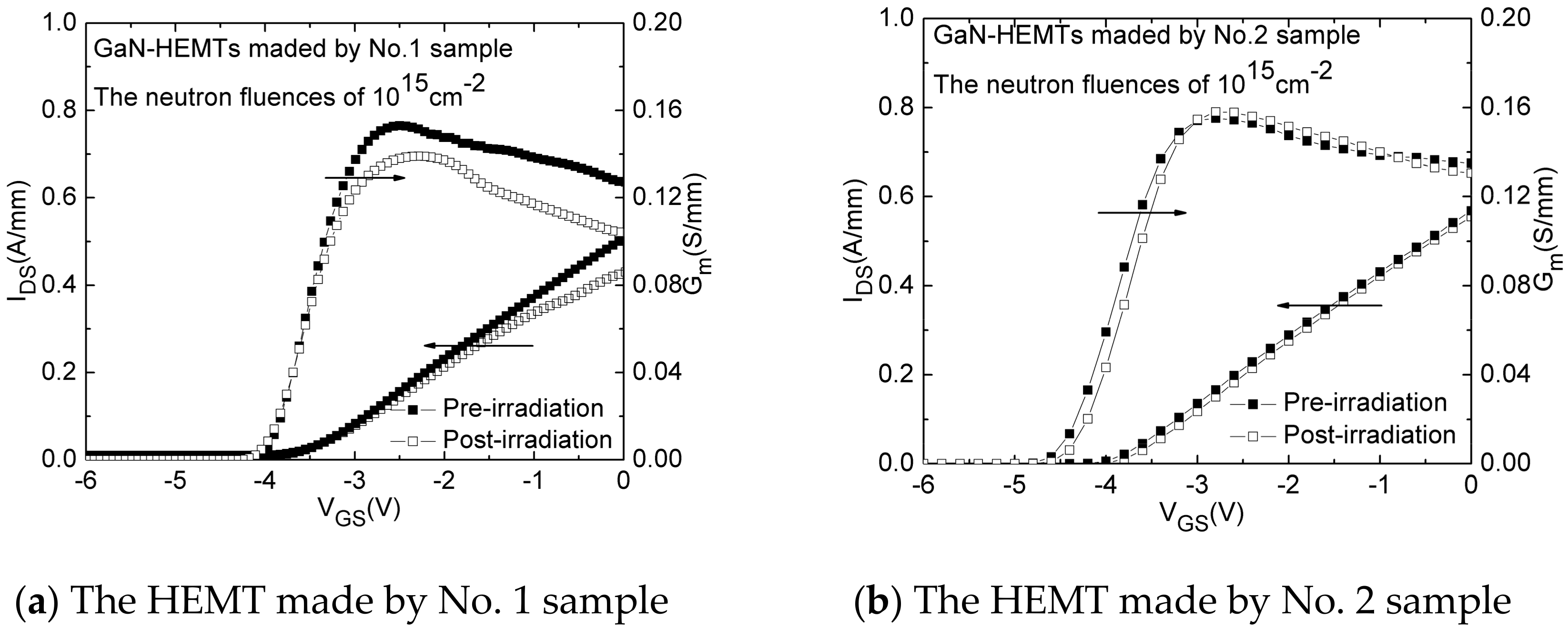
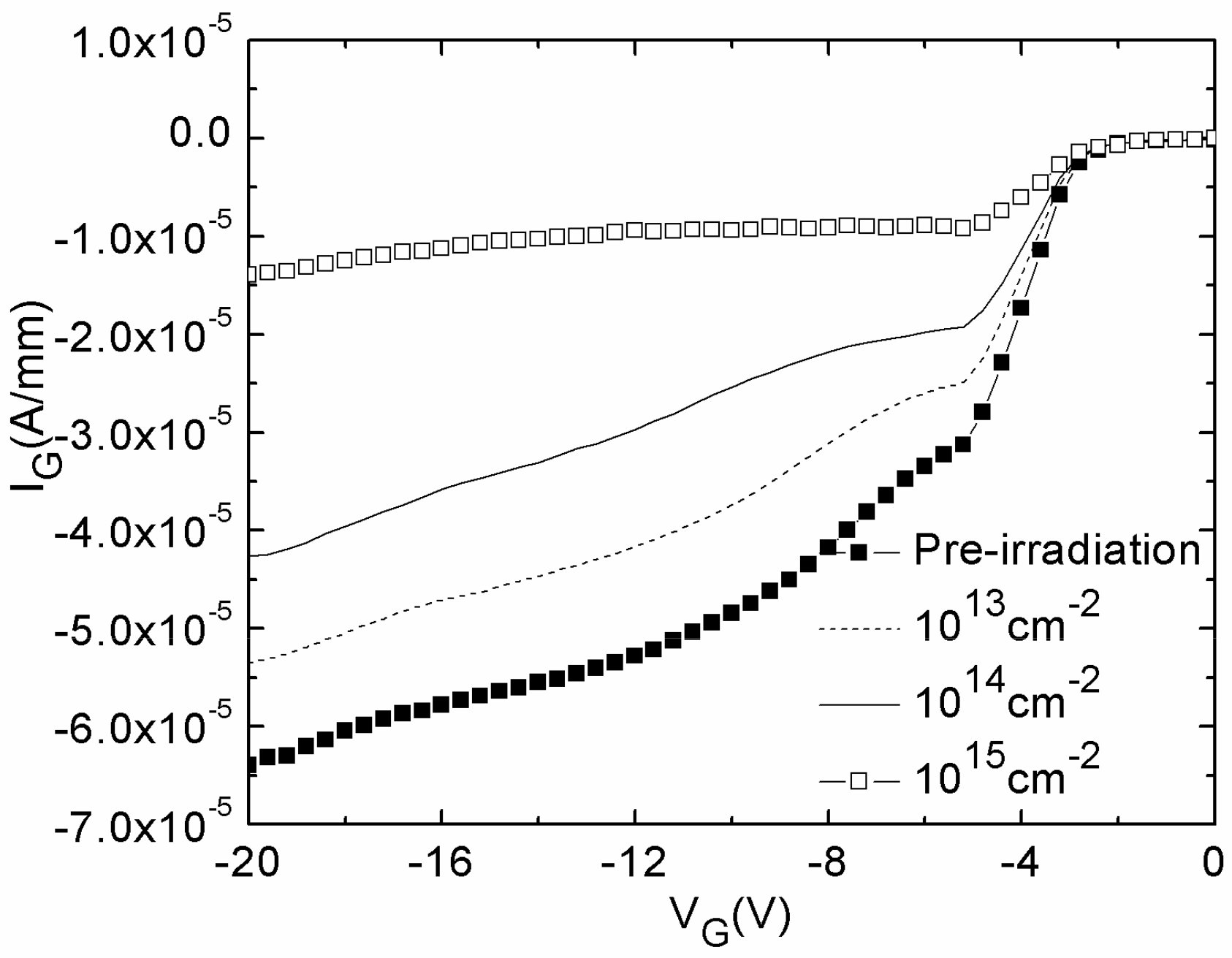
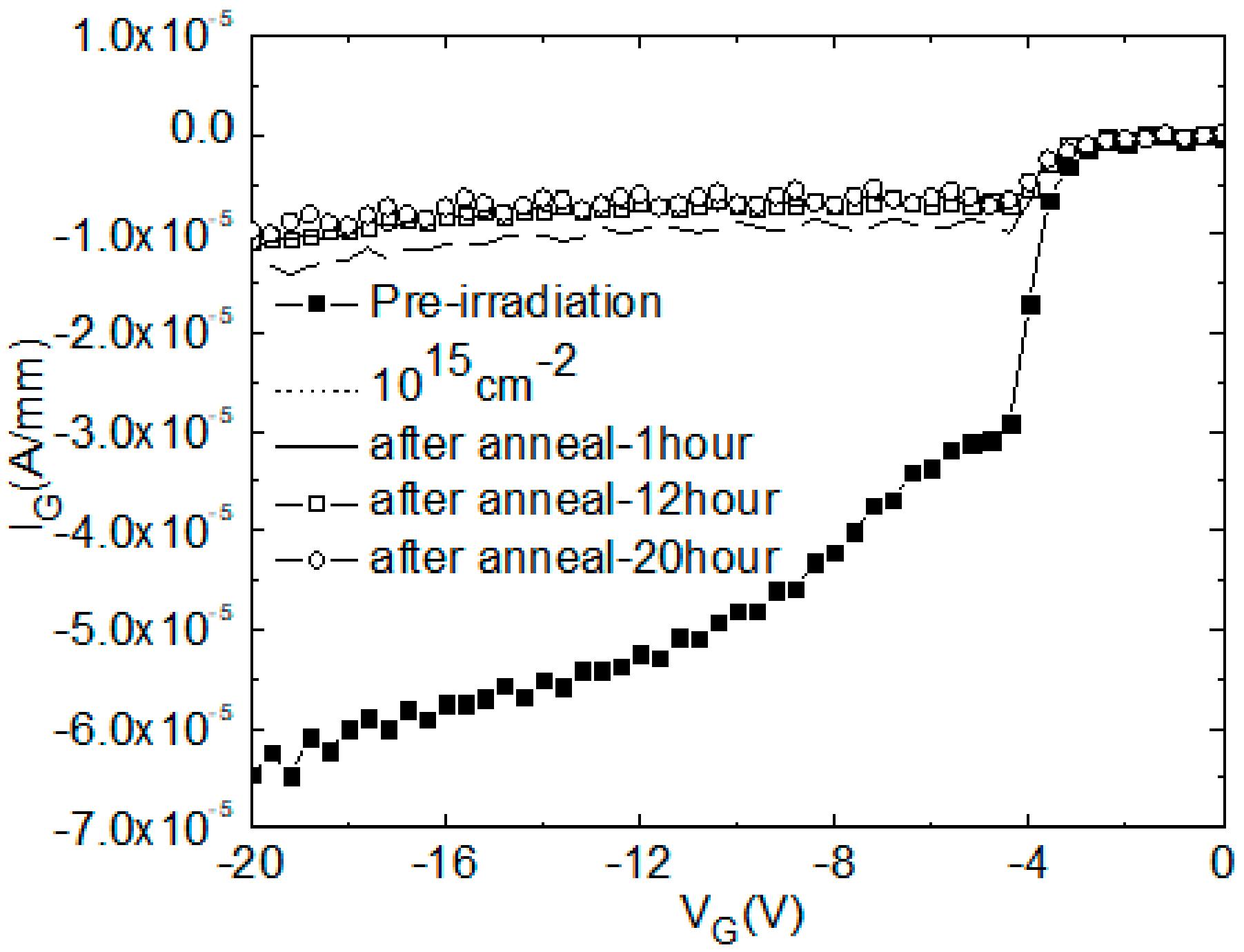

| No. | (002) FWHM/arcsec | (102) FWHM/arcsec | ||
|---|---|---|---|---|
| Pre-Irradiation | Post-Irradition | Pre-Irradiation | Post-Irradition | |
| 1 | 588 | 647 | 912 | 1079 |
| 2 | 310 | 311 | 789 | 813 |
| No. | RMS | ρ | d |
|---|---|---|---|
| 1 | 2.16 | 1.35 | 2.08 |
| 2 | 2.27 | 1.18 | 1.33 |
| No. | ns/(1013 cm−2) | μ/(cm2·V−1·s−1) | Rsh/(Ω/γ) | |||
|---|---|---|---|---|---|---|
| Pre-Irradiation | Post-Irradition | Pre-Irradiation | Post-Irradition | Pre-Irradiation | Post-Irradition | |
| 1 | 1.68 | 1.45 | 698 | 716 | 519 | 548 |
| 2 | 1.94 | 1.88 | 937 | 951 | 407 | 419 |
© 2018 by the authors. Licensee MDPI, Basel, Switzerland. This article is an open access article distributed under the terms and conditions of the Creative Commons Attribution (CC BY) license (http://creativecommons.org/licenses/by/4.0/).
Share and Cite
Gu, W.; Xu, X.; Zhang, L.; Gao, Z.; Hu, X.; Zhang, Z. Study on Neutron Irradiation-Induced Structural Defects of GaN-Based Heterostructures. Crystals 2018, 8, 198. https://doi.org/10.3390/cryst8050198
Gu W, Xu X, Zhang L, Gao Z, Hu X, Zhang Z. Study on Neutron Irradiation-Induced Structural Defects of GaN-Based Heterostructures. Crystals. 2018; 8(5):198. https://doi.org/10.3390/cryst8050198
Chicago/Turabian StyleGu, Wenping, Xiaobo Xu, Lin Zhang, Zhiyuan Gao, Xiaochuan Hu, and Zan Zhang. 2018. "Study on Neutron Irradiation-Induced Structural Defects of GaN-Based Heterostructures" Crystals 8, no. 5: 198. https://doi.org/10.3390/cryst8050198




